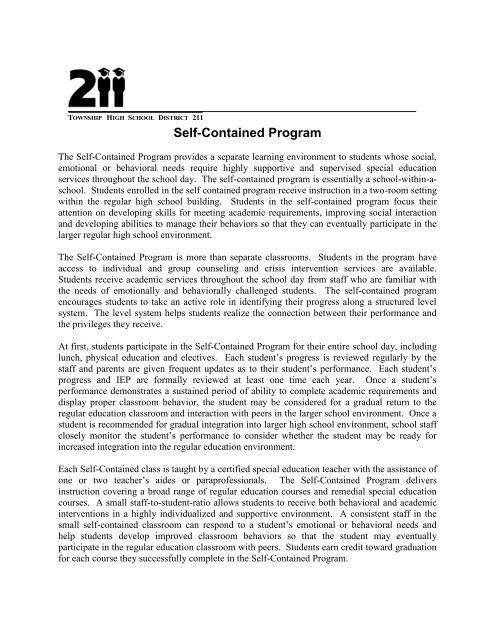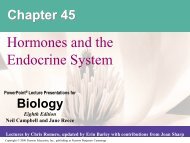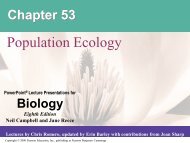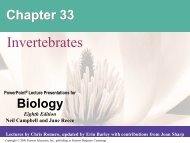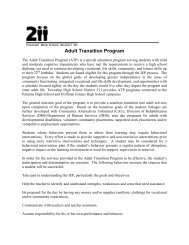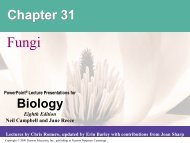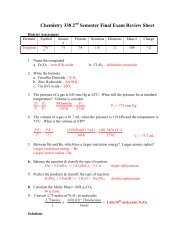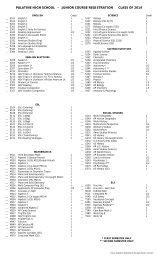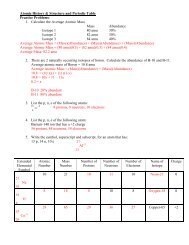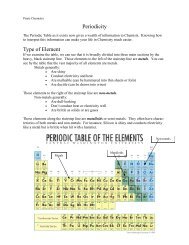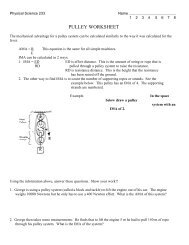Emotional Disabilities Self Contained Program - Palatine High ...
Emotional Disabilities Self Contained Program - Palatine High ...
Emotional Disabilities Self Contained Program - Palatine High ...
Create successful ePaper yourself
Turn your PDF publications into a flip-book with our unique Google optimized e-Paper software.
TOWNSHIP HIGH SCHOOL DISTRICT 211<br />
<strong>Self</strong>-<strong>Contained</strong> <strong>Program</strong><br />
The <strong>Self</strong>-<strong>Contained</strong> <strong>Program</strong> provides a separate learning environment to students whose social,<br />
emotional or behavioral needs require highly supportive and supervised special education<br />
services throughout the school day. The self-contained program is essentially a school-within-aschool.<br />
Students enrolled in the self contained program receive instruction in a two-room setting<br />
within the regular high school building. Students in the self-contained program focus their<br />
attention on developing skills for meeting academic requirements, improving social interaction<br />
and developing abilities to manage their behaviors so that they can eventually participate in the<br />
larger regular high school environment.<br />
The <strong>Self</strong>-<strong>Contained</strong> <strong>Program</strong> is more than separate classrooms. Students in the program have<br />
access to individual and group counseling and crisis intervention services are available.<br />
Students receive academic services throughout the school day from staff who are familiar with<br />
the needs of emotionally and behaviorally challenged students. The self-contained program<br />
encourages students to take an active role in identifying their progress along a structured level<br />
system. The level system helps students realize the connection between their performance and<br />
the privileges they receive.<br />
At first, students participate in the <strong>Self</strong>-<strong>Contained</strong> <strong>Program</strong> for their entire school day, including<br />
lunch, physical education and electives. Each student’s progress is reviewed regularly by the<br />
staff and parents are given frequent updates as to their student’s performance. Each student’s<br />
progress and IEP are formally reviewed at least one time each year. Once a student’s<br />
performance demonstrates a sustained period of ability to complete academic requirements and<br />
display proper classroom behavior, the student may be considered for a gradual return to the<br />
regular education classroom and interaction with peers in the larger school environment. Once a<br />
student is recommended for gradual integration into larger high school environment, school staff<br />
closely monitor the student’s performance to consider whether the student may be ready for<br />
increased integration into the regular education environment.<br />
Each <strong>Self</strong>-<strong>Contained</strong> class is taught by a certified special education teacher with the assistance of<br />
one or two teacher’s aides or paraprofessionals. The <strong>Self</strong>-<strong>Contained</strong> <strong>Program</strong> delivers<br />
instruction covering a broad range of regular education courses and remedial special education<br />
courses. A small staff-to-student-ratio allows students to receive both behavioral and academic<br />
interventions in a highly individualized and supportive environment. A consistent staff in the<br />
small self-contained classroom can respond to a student’s emotional or behavioral needs and<br />
help students develop improved classroom behaviors so that the student may eventually<br />
participate in the regular education classroom with peers. Students earn credit toward graduation<br />
for each course they successfully complete in the <strong>Self</strong>-<strong>Contained</strong> <strong>Program</strong>.
Students whose behaviors prevent them or others from learning may require behavioral<br />
interventions. Every effort is made to provide supportive and non-restrictive interventions prior<br />
to using more restrictive interventions and techniques. A student may be considered for a<br />
behavioral intervention plan if the student’s behavior presents a regular pattern of disruption,<br />
negative impact on the learning environment or need for support, supervision or removal.<br />
In order for the services provided in the <strong>Self</strong>-<strong>Contained</strong> <strong>Program</strong> to be effective, the student’s<br />
participation and determination are essential. The following behaviors increase the chances that<br />
a student will be successful:<br />
Take part in understanding the IEP, particularly the goals and objectives.<br />
Help the teacher to identify and understand academic strengths, weaknesses and areas that need<br />
assistance.<br />
Be prepared for classes.<br />
assignments at every class.<br />
Have the necessary books, pens, pencils, paper, notebooks and<br />
Go to every class every day and on time.<br />
Ask the teacher for help, extra time, or other assistance when needed.<br />
Inform the teacher if any academic subject or skill area is particularly difficult.<br />
Use the learning strategies that are taught.<br />
Communicate with teachers and teacher assistants.<br />
Assume responsibility for his or her own academic performance and behavior.<br />
The <strong>Self</strong>-<strong>Contained</strong> <strong>Program</strong> can be successful if the student exhibits the behaviors described<br />
above. While the program and its teachers provide a great deal of attention within a small<br />
environment designed to be encouraging, the ultimate responsibility belongs to the student.


